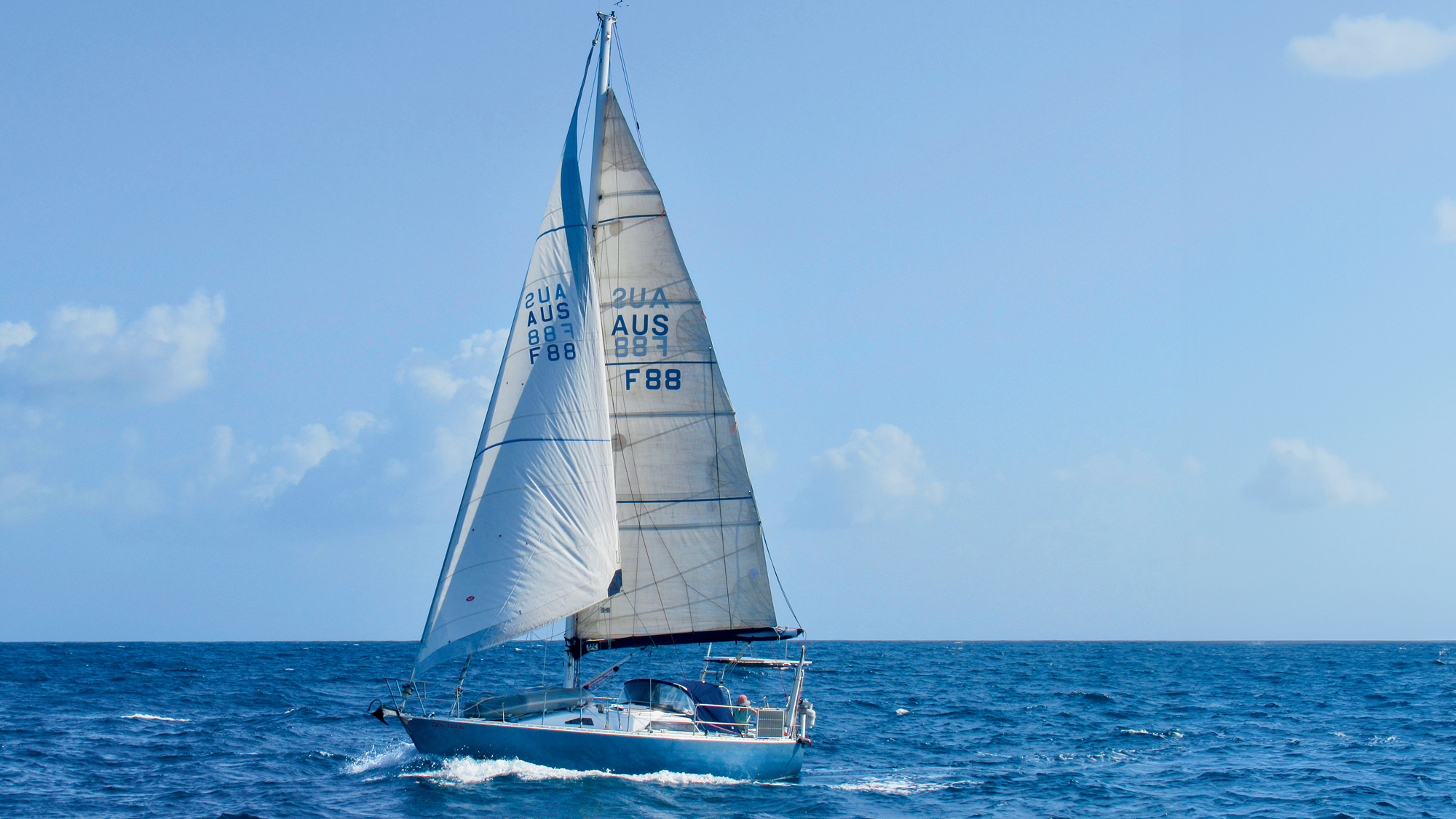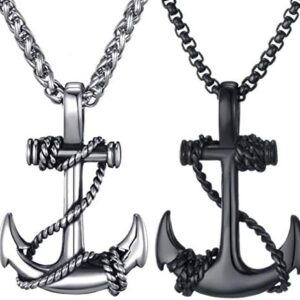Our Eighties Yamazaki Yachts 34, Zen Once more, is an IOR (Worldwide Offshore Rule) 3/4 tonner masthead cutter, with a fin keel and a skeg-hung rudder, displacing 6,000kg loaded for blue-water cruising. Once we bought her in 2010 she had a full-sized mainsail, typical mainsheet and traveller, a easy rope kicker, two mainsail clew reefing strains, and ‘slugs in mast slot’ mainsail luff attachment.
She was designed for absolutely crewed racing and we shortly discovered that the principle challenge with the mainsail techniques was security. The total-sized mainsail might have been good for gentle airs while racing with 4 crew on the rail, but it surely was simply too massive for cruising.
The mainsheet and traveller had been within the cockpit, making a ‘death-zone’ throughout gybes. The rope kicker required a increase topping raise which proved to be a nuisance, and reefing with out tack strains necessitated work on the mast. The mainsail luff attachment was troublesome to reef because of the slugs jamming. In brief, she was simply too hazardous for two-handed cruising.
She may be very simply pushed, so slowing her down is commonly our major concern at sea. With the unique mainsail, we very hardly ever set the complete sail. This meant that one of many reefing strains was at all times in use and placing within the third reef required re-reeving the primary reef line.
So, when the time lastly got here for a brand new mainsail we had it made with the first-reef luff size and two deep reef factors.
Upwind the brand new sail works nicely in gentle breezes. A notable instance could be the time once we sailed 600 miles to windward in 10-15 knots from Panama to Jamaica – and would have left most displacement 40ft cruisers in our wake!
Broad-reaching with the brand new sail and our 130% yankee will give us boat speeds of 5 knots in 6-8 knots obvious – a 120-mile day by day common and completely respectable for our little cruiser. It’s truthful to say that our new smaller foremost has actually been an enormous enchancment.

A second increase tang secures a climbing descender which makes a extremely efficient increase brake
Management enhancements
Through the years we’ve additionally added a Selden Rodkicker increase help system, a number of foot blocks, a increase brake, Tides Marine SailTrack and mainsail tack reefing strains, and have utterly re-invented the mainsheet.
The Rodkicker eliminates the necessity for a topping raise, whereas extra footblocks permit management of the headsail sheet, reaching sheet, staysail sheet and increase brake strains with one cockpit winch per facet. The increase brake protects in opposition to involuntary gybes, and lets them occur safely in the event that they do happen.
The SailTrack offers a low-friction slot for the brand new mainsail vehicles, simplifying and accelerating reefing operations. The tack reefing strains help reefing solely from the cockpit, and the brand new mainsheet is now solely outdoors the cockpit. The adjustments imply we now have a safer boat, having saved us from harm, and our boat from harm, on many events.

Twin lockable foot blocks changed the unique single foot blocks on all sides
Foot blocks
Initially, we had one non-lockable twin foot block on all sides to guide strains to the cockpit coaming winches. They had been sized for 14mm-plus strains, as required within the Eighties. As a result of we had a single winch on every coaming, just one line may very well be used at a time.
We might run the second line throughout the cockpit to the windward winch, however that winch would normally belay (make quick) the checkstay (adjustable keep controlling mast bend). We needed 4 8-10mm strains all sides (headsail sheet, reaching sheet, staysail sheet and increase brake).
The reaching sheet runs via a toerail-mounted block to guide the headsail outboard – very helpful for commerce winds crusing. We additionally changed every outdated twin foot block with two twin lockable foot blocks. This was an enormous enchancment. It meant we might trim one line, lock it, and swap one other line onto the winch. The modification was very important for putting in a increase brake. Our headsail sheets are 8mm polyester-sheathed Dyneema and the increase brake line is 10mm double-braid polyester.
Growth brake
Initially we had a single tang (steel strip) below the increase for the kicker. It had two holes permitting each a stable kicker and increase brake to be fitted. We used a shackle and quick webbing strop to attach a mountaineering ‘determine of eight’ descender to the increase, with the webbing stopping metal-to-metal contact between the kicker and the descender.
Nevertheless, the stable kicker started to chaff the strop which required common substitute. So, throughout a refit we had a second tang fitted aft of the unique tang, with the stable kicker and increase brake sharing an prolonged backing plate. This solved the issue and drastically bolstered the increase.

The double-reefed mainsail isn’t any greater than a trysail
The increase brake works brilliantly. A single increase brake management line leads ahead from a foot block to a block shackled to the toerail, as much as and thru the descender and all the way down to the opposite facet and aft to a foot block. The 10mm double-braid polyester places some ‘elastic’ within the system.
We at all times use the increase brake when crusing downwind, so it’s completely rigged. To activate it, we merely take up any slack on the windward facet and lock, then manually heave the leeward facet tight and lock. No winching is required. If an unintentional gybe happens the increase strikes throughout slowly.
Once we are getting ready to gybe we unlock the outdated windward facet and in the course of the gybe the increase brake will successfully sluggish the increase because it swings throughout.

The Selden Rodkicker with an inner gasoline strut
Strong kicker
Altering to a stable kicker eradicated the necessity for a increase topping raise. The Selden Rodkicker’s inner gasoline strut pushes the increase up once we ease the kicker line. When reefing, this ‘scandalising’ of the mainsail removes leach pressure, making clew line tensioning simple.
Mainsheet moved
Initially we had a traditional single mainsheet operating from a cockpit-wide traveller. The traveller was on the bridge deck instantly aft of the companionway. These techniques could be scary throughout intentional gybes and intensely harmful throughout unintentional gybes.
Throughout a refit we had the traveller eliminated and added a stainless-steel arch with mounts for 2 mainsheets – one on both facet. From a 2:1 sort out every mainsheet is led ahead to the gooseneck, all the way down to the deck and again to the coachroof clutch and winch.
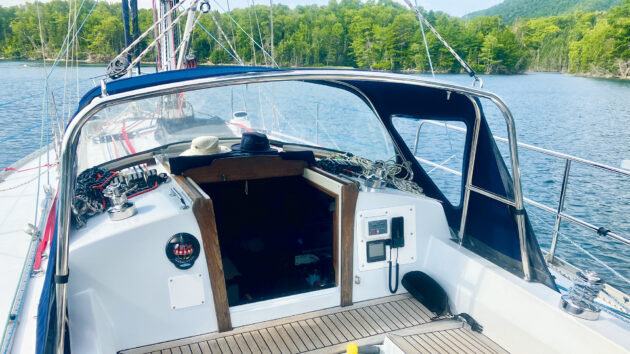
Clear cockpit with the mainsheet management system now completely out of the way in which
When crusing upwind the windward sheet acts as a traveller and the leeward sheet and the kicker itself act as twin kickers. When gybing, the mainsheet falls undergo above the sprayhood nicely away from the cockpit – a lot safer.
The arch contains twin 38mm-diameter, interconnected tubes with the ahead tube securing the sprayhood and the aft tube offering a handhold. We positioned the arch such that the sprayhood prolonged additional aft, drastically bettering the shelter it offers. The ft of the 2 tubes are splayed aside for energy, with a big baseplate between. The arch is bolted via the cockpit coamings with huge backing plates beneath.
Reefing tack strains
For security causes we needed to have the ability to reef from the cockpit, which meant including tack strains and modifying the mast gooseneck. The outdated gooseneck had typical open hooks for mainsail luff reefing cringles. We would have liked closed rings via which we may lead tack strains. From there every tackline might run all the way down to the deck and aft through deck organisers to coachroof clutch and winch.

A brand new chrome steel gooseneck permits Mike to reef the mainsail from the cockpit
Throughout a refit we had a brand new chrome steel gooseneck fabricated. It’s a factor of magnificence and does the job very nicely.
Our mainsail has webbing strops via every luff reef cringle with D-rings at every finish. The tack strains connect to the D-rings which may’t get via the gooseneck rings. Our mainsail has solely two reef factors since it’s first-reef measurement (i.e. not full hoist). We will absolutely reef the mainsail with our two units of tack and clew strains. The second reef is trysail-sized. The reefing strains are double-braid polyester – 8mm for tack and 10mm for clew.
Luff observe
The latest modification that now we have made to Zen Once more has been to efficiently set up a Tides Marine SailTrack. Beforehand our mainsail luff had vehicles and slugs which fed up the mast’s extruded slot. This labored fairly nicely but it surely typically required winching the luff down through the tack strains.
Once we had been reefing the full-length batten vehicles pushed ahead and jammed even with wind out of the sail.
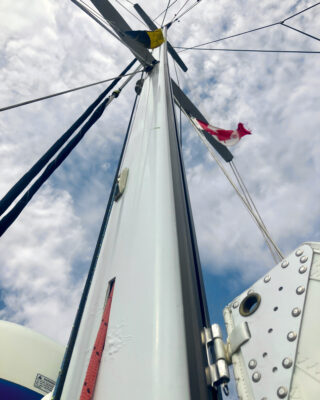
The SailTrack’s low friction plastic slot makes hoisting and decreasing the mainsail a lot simpler
Low friction
We fitted the SailTrack once we changed the mainsail, which meant we had been in a position to have the sail constructed to go well with. Becoming the SailTrack was easy with the mast out of the boat for a refit, however it may be finished with the mast stepped. The SailTrack merely slides up the extruded mast slot and is completely secured in place.
As an alternative of the mainsail vehicles/slugs working within the 38-year-old mast slot they now work in a low-friction plastic slot. The SailTrack has remodeled our mainsail dealing with because the sail now hoists simply and actually falls down. The tack line’s objective now’s to carry the reef tack down – it’s barely wanted to haul down the tack. We nonetheless launch the kicker and luff the sail throughout these operations.

Dyneema wire and soft-attach blocks are robust and quiet
Smooth connect blocks
For the mainsheets and different functions we use Harken soft-attach blocks. These use 3mm Dyneema wire. We’ve used them throughout a number of oceans, changing the wire each couple of years to keep away from UV-induced failure. We nonetheless use stainless shackles on toerail-attached blocks because of the toerail’s tough inside edges.
So, after a decade of optimisation we now have a mainsail dealing with system that works flawlessly. A number of the modifications weren’t low cost however they’ve all made crusing safer and extra enjoyable.

Set up a increase brake to sluggish the increase’s swing throughout a gybe
Preventer or increase brake?
When crusing downwind you could wish to set a increase preventer or increase brake to eradicate the danger of an unintentional gybe. A preventer holds the increase ahead utilizing a protracted line from the tip of the increase, ahead to a turning block, then again to a clutch or jammer within the cockpit.
For those who plan to deliberately gybe with a single preventer, you’re unlikely to wish to go all the way in which ahead to re-rig it, which suggests you’ll want two preventers, one for all sides – a cumbersome answer that may result in strains getting caught.
In case your preventer fails to do its job, the following unintentional gybe could be dramatic and harmful. I’ve identified many boats which have had mainsheet, traveller or increase damaged by gybes when the preventer failed. Even when nothing breaks, the boat will pirouette – as a result of the principle is pinned to at least one facet by the preventer – placing an enormous load on the rudder.
A increase brake, in the meantime, makes use of friction created by strains to decelerate the swing of the increase. The quantity of friction utilized to the swing is managed by the variety of turns you’re taking round a central hub on the increase.
Growth brakes don’t essentially require a big change in fact when gybing. We merely launch the outdated windward facet of the increase brake, flip downwind, winch in the principle, gybe, ease the mainsheet, after which lock the increase brake.
Loved studying this?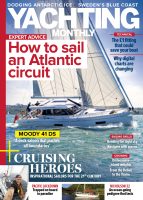
A subscription to Yachting Month-to-month journal prices round 40% lower than the duvet worth, so it can save you cash in comparison with shopping for single points.
Print and digital editions are available through Magazines Direct – where you can also find the latest deals.
YM is full of info that can assist you get probably the most out of your time on the water.
-
-
- Take your seamanship to the following degree with suggestions, recommendation and abilities from our specialists
- Neutral in-depth critiques of the most recent yachts and gear
- Cruising guides that can assist you attain these dream locations
-
Observe us on Facebook, Twitter and Instagram.

